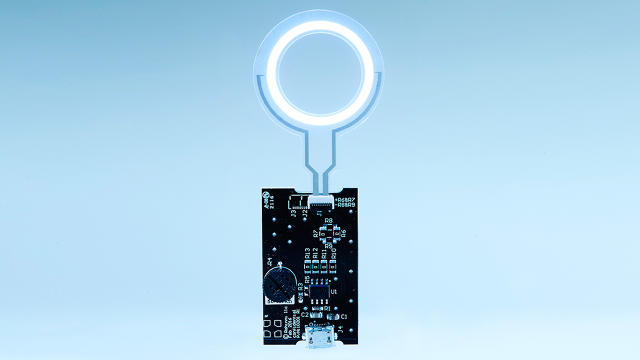As usual, Cody Peterson is talking about making something thin—unimaginably thin. Peterson, who started out developing skinny computer keyboards and went on to found Rohinni, a company devoted to paper-thin lighting, is explaining the micro-light-emitting diodes (LEDs) at the heart of the company’s new technology PiXey.
“You probably can’t see it with your eye,” he says of a single micro-LED. “It’s a speck. That’s the ballpark we work in.”

Over the last three years, Rohinni, based in Coeur d’Alene, Idaho, has devised what Peterson says is a novel way of working with those rather sensitive and microscopic components. The result, he says, is a light source that’s about one-tenth as thick as regular LEDs and about six times brighter, but costs roughly the same. It’s also up to ten times more power-efficient when compared to integrated light solutions.
In Rohinni’s trademark filing for PiXey in September, the company hinted at the potential markets for its breakthrough, including mobile devices, TVs, and other devices with backlit electronic displays. But at the moment, Peterson and the team are focused on the one sector that’s closest to hitting store shelves (and debuting next month at CES): laptop keyboards.
Earlier this month, Rohinni’s engineers traveled to Suzhou, China, as a part of a new joint venture with KoJa, the Taiwanese company that dominates membrane switches for keyboards; it has nearly a third of the market worldwide. Luumii, the newly formed company, is ramping up to begin production of Luumii Light, a bright, paper-thin underlayer. In the second quarter of 2017, says Kevin Lin, Luumii’s CEO, the new production line will produce up to 100,000 components a month. By the end of next year, the goal is 1 million to 2 million, as Luumii Light is incorporated into name-brand laptops.

“When you can create a light source that thin, you are building something very different from what’s out in the market,” Lin said in an email from China.
Thinner and more efficient backlighting would help manufacturers reduce laptop profiles even further and extend battery life.
From Lightpaper To Luumii Light
Rohinni, which has raised $11 million in funding since it launched in 2013, isn’t the only company dabbling in micro-LEDs, but it claims to have pioneered a new approach. PiXey is an evolution of its initial technology, Lightpaper. The company created a method of treating micro-LEDs like ink to print glowing sheets of light at high speed (25 feet/minute). In 2014, at a Fast Company conference in San Francisco, Peterson wowed the crowd with the first on-stage demonstration of that technology, which—true to its name—was a paper-like sheet of dazzling light. But Lightpaper needed to be refined for commercialization. The uniformity of the light wasn’t as consistent as it needed to be.
Rohinni, which has filed for 42 patents thus far, spent the past 18 months building a robot capable of placing the tiny diodes with precision without sacrificing the speed necessary for mass manufacturing. “We’re not only putting them down fast,” says Peterson, “but exactly where you need them—within two or three microns of accuracy.”

Keyboards are an appropriate first application given Rohinni’s roots. Peterson and cofounder Andy Huska had worked together at Pacinian, which Peterson also cofounded. The startup, which was acquired by input-device maker Synaptics in 2012, specialized in thin computer keyboard technology. At Rohinni, says Peterson, “We took the same approach that we took to keyboards and touchpads and applied it to light.”
Last summer, after Rohinni conducted an initial demo for KoJa representatives in Austin, KoJa dispatched Lin from China to Idaho to see the technology in person. “I was quite puzzled and amazed by how [Rohinni] can manipulate and print micro-LED directly onto flexible circuits,” Lin said.
Soon after, the joint venture and Luumii were in the works. Peterson is counting on a similar reaction as he introduces Rohinni’s micro-LEDs to other markets. “That’s when people go crazy,” he says of seeing and holding the light. “It’s just so elegant, so thin, so much brighter when you compare it to normal technology that you don’t have to say a lot.”
Fast Company , Read Full Story
(53)